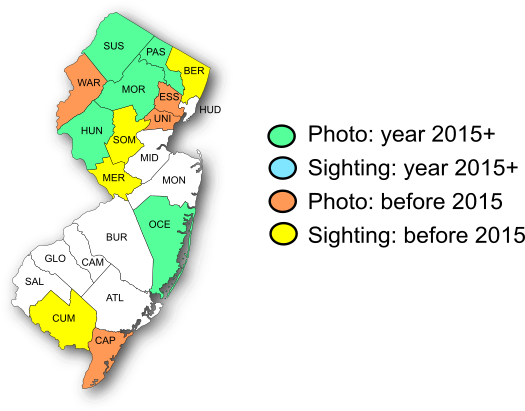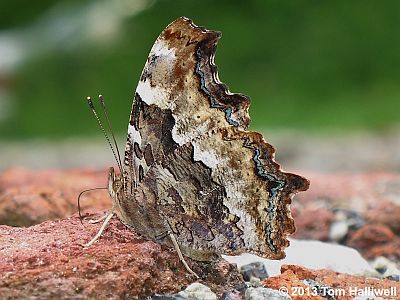New Jersey Butterfly Club
A chapter of the North American Butterfly Association (NABA)
Compton Tortoiseshell
Nymphalis vau-album
Identification: Medium—2.6” (a little larger than Question Mark). Sexes similar. Above: Black, orange, and yellow, with eye-catching single white spots on leading edges of FW and HW. Below: FW and HW mottled gray-brown, with basal half of wings distinctly darker than the outer half. Three broad, wavy, whitish marks intersect leading edge of FW. A small, shallowly v- or j-shaped silver mark in center of HW can be hard to see.
NJ Status and Distribution: Classified as Special Concern in NJ. Resident. An increasingly rare northern species that formerly occurred as far south as northern Somerset and Hunterdon counties, but the very few recent observations have been confined to northern Sussex.

Habitat: This is primarily a woodland species that seldom nectars. Most often seen on dirt roads or parking lots bordered by mature deciduous forest. Sometimes seen nectaring in early spring on the catkins of willows (Salix).
Flight Period: March into November. Adults overwinter and generally emerge in March. The single new brood usually emerges in late June or early July and flies into November, with time out for aestivation in the latter half of summer. Peak flight time is in April-May, and July. Extreme dates: 2/26—11/18.
Caterpillar Food Plants: Birches (Betula), poplars (Populus), and willows (Salix).
Overwintering Stage: Adult.
Good Locations: None, anymore, but best chances would be High Point SP or Wawayanda SP.
Comments: Sadly, this beautiful butterfly appears to be withdrawing north, possibly as a result of climate change.


